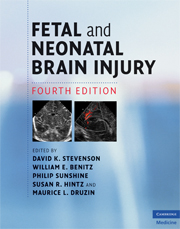Book contents
- Frontmatter
- Contents
- List of contributors
- Foreword
- Preface
- Section 1 Epidemiology, pathophysiology, and pathogenesis of fetal and neonatal brain injury
- Section 2 Pregnancy, labor, and delivery complications causing brain injury
- Section 3 Diagnosis of the infant with brain injury
- Section 4 Specific conditions associated with fetal and neonatal brain injury
- Section 5 Management of the depressed or neurologically dysfunctional neonate
- 39 Neonatal resuscitation: immediate management
- 40 Improving performance, reducing error, and minimizing risk in the delivery room
- 41 Extended management following resuscitation
- 42 Endogenous and exogenous neuroprotective mechanisms after hypoxic–ischemic injury
- 43 Neonatal seizures: an expression of fetal or neonatal brain disorders
- 44 Nutritional support of the asphyxiated infant
- Section 6 Assessing outcome of the brain-injured infant
- Index
- Plate section
- References
40 - Improving performance, reducing error, and minimizing risk in the delivery room
from Section 5 - Management of the depressed or neurologically dysfunctional neonate
Published online by Cambridge University Press: 12 January 2010
- Frontmatter
- Contents
- List of contributors
- Foreword
- Preface
- Section 1 Epidemiology, pathophysiology, and pathogenesis of fetal and neonatal brain injury
- Section 2 Pregnancy, labor, and delivery complications causing brain injury
- Section 3 Diagnosis of the infant with brain injury
- Section 4 Specific conditions associated with fetal and neonatal brain injury
- Section 5 Management of the depressed or neurologically dysfunctional neonate
- 39 Neonatal resuscitation: immediate management
- 40 Improving performance, reducing error, and minimizing risk in the delivery room
- 41 Extended management following resuscitation
- 42 Endogenous and exogenous neuroprotective mechanisms after hypoxic–ischemic injury
- 43 Neonatal seizures: an expression of fetal or neonatal brain disorders
- 44 Nutritional support of the asphyxiated infant
- Section 6 Assessing outcome of the brain-injured infant
- Index
- Plate section
- References
Summary
Introduction
In 1999 the Institute of Medicine (IOM) published To Err is Human: Building a Safer Health System, a report on human error and patient safety in the USA. In this report the authors estimate that between 44,000 and 98,000 Americans die each year as a result of medical errors. Although this figure has been highly debated, it is based on extrapolation of the data contained in published studies out of Colorado, Utah, and New York. The 1999 report was followed in 2001 by another from the IOM, Crossing the Quality Chasm: A New Health System for the 21st Century, where the type of interventions, including training methodologies, necessary to improve patient safety were discussed. Subsequently in 2004 the Joint Commission for the Accreditation of Healthcare Organizations (JCAHO) published a Sentinel Event Alert describing ineffective communication as a major cause in almost three-quarters of the cases of neonatal mortality or severe neonatal morbidity (lifelong serious neurological compromise) reported to that agency. JCAHO recommended that hospitals that deliver newborns establish a system of training that incorporates behavioral skills such as teamwork and effective communication, and that they conduct regular clinical drills in delivery-room emergencies with these drills followed by constructive debriefings. Despite the recommendations by the IOM and JCAHO, healthcare has yet to fully examine the complex relationship among training, human performance, and medical error, and development and implementation of such training programs remains challenging.
- Type
- Chapter
- Information
- Fetal and Neonatal Brain Injury , pp. 464 - 469Publisher: Cambridge University PressPrint publication year: 2009



